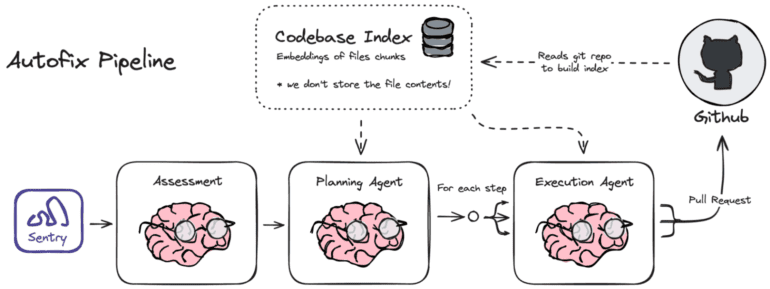- Sentry introduces AI Autofix, enhancing debugging and error resolution in production code.
- Autofix utilizes contextual data to suggest fixes, operating as a human-in-the-loop tool.
- It focuses on code-level problem-solving and complements existing AI-based coding tools.
- Agent-based architecture continuously monitors errors, providing developers with actionable insights.
- It offers a seamless user experience with options for additional context input or AI-generated fixes.
- Presents comprehensive action plans with diffs and facilitates integration through pull requests.
- Supports major languages with initial testing focused on JavaScript and Python.
- Relies on third-party models, necessitating user consent for data sharing.
Main AI News:
In the realm of software development, efficient debugging and error resolution are paramount. Sentry, a long-standing ally to developers in monitoring and debugging production code, now introduces AI Autofix, a groundbreaking feature poised to revolutionize this process. Leveraging the vast contextual data at Sentry’s disposal regarding a company’s production environment, Autofix offers intelligent suggestions for fixes whenever errors arise. Despite its moniker, Autofix is not a fully automated system, a prospect that may unsettle some developers. Rather, it operates as a human-in-the-loop tool, akin to having a junior developer available on demand, as elucidated by the company.
Tillman Elser, Sentry’s engineering manager, emphasizes the shift in perspective facilitated by Autofix. Rather than solely scrutinizing application performance or errors from a systemic standpoint, the focus is directed toward evaluating and resolving issues at the code level. This approach aligns with Sentry’s broader product strategy, aiming to expedite the resolution of production issues by leveraging contextual insights. While other AI-based coding tools excel at auto-completing code within integrated development environments (IDEs), Autofix stands out by proactively identifying and addressing issues within the production environment.
At the core of Autofix’s functionality lies an agent-based architecture, which continuously monitors for errors and assesses whether a code change could rectify the issue. Crucially, developers retain oversight throughout this process. Autofix offers a seamless user experience, empowering developers to augment the AI’s understanding by providing additional context or opting for AI-generated fixes via the “gimme fix” button.
Upon identifying an issue, Autofix undertakes a systematic approach to resolution, presenting developers with a comprehensive plan of action encapsulated in a diff that outlines proposed changes. If deemed satisfactory, Autofix seamlessly facilitates the integration of these changes through pull requests.
Autofix boasts broad language support, although initial testing predominantly focused on JavaScript and Python. Nonetheless, its efficacy may vary, with limitations arising from insufficient contextual data being a primary concern. Sentry acknowledges its reliance on third-party models from entities such as OpenAI and Anthropic, necessitating user consent for data sharing. Looking ahead, Sentry envisions refining its models and potentially offering an in-house solution, underscoring its commitment to user privacy and product enhancement.
Conclusion:
Sentry’s introduction of AI Autofix marks a significant advancement in the realm of software development, streamlining debugging processes and empowering developers with intelligent insights. By leveraging contextual data and maintaining developer oversight, Autofix offers a promising solution for enhancing productivity and efficiency in production environments. Its reliance on third-party models underscores the collaborative nature of innovation in the market, highlighting the importance of user consent and data privacy considerations. As the demand for efficient debugging solutions continues to rise, Sentry’s Autofix positions itself as a competitive offering poised to meet the evolving needs of developers in an increasingly complex technological landscape.

